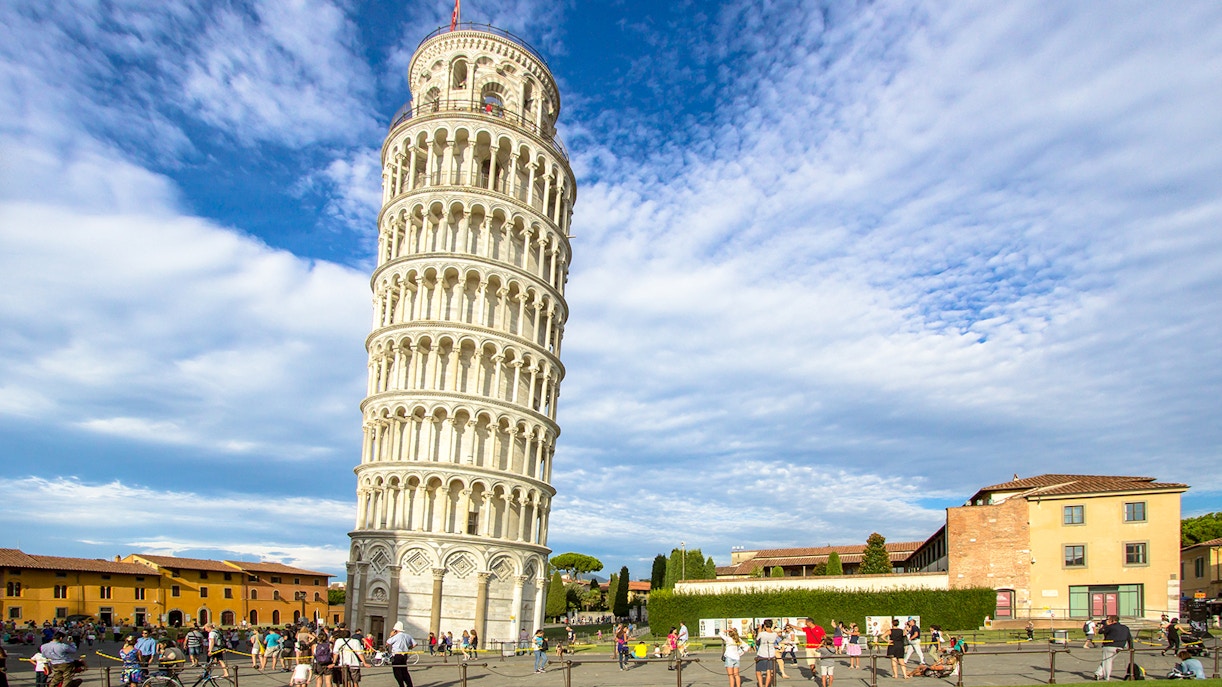As the tower is tilted off the center of gravity by nearly 4 degrees, you will be able to feel the tilt as you ascend to the top. Some visitors might also feel a little dizzy.
Highlights of the Leaning Tower of Pisa: The iconic tilt, construction & more
Nestled in Pisa, the Leaning Tower stands tall with a captivating tilt, a testament to architectural miscalculation. Its quirky angle, unintended yet iconic, draws history enthusiasts and curious travelers alike from world over. This freestanding...
Quick Information
RECOMMENDED DURATION
1 hour
TICKETS
From € 24.40
EXPECTED WAIT TIME - STANDARD
30-60 mins (Peak), 0-30 mins (Off Peak)
EXPECTED WAIT TIME - SKIP THE LINE
0-30 mins (Peak), 0-30 mins (Off Peak)
Did you know?
Construction of the Leaning Tower of Pisa began in 1173, but it was halted in 1178 due to funding issues. The tower remained incomplete for almost a century until work resumed in 1272.
Uncover the legend of Galileo Galilei's famous experiment from the Leaning Tower. While unproven, the story goes that he supposedly dropped objects to test the acceleration due to gravity.
Mussolini, in a bid to straighten the tower, got several workers to drill hundreds of holes into its foundation. The result: the tower's tilt became more pronounced!
Buy tickets to Leaning Tower of Pisa
Technical information about the Leaning Tower

Elevation of the Square of Miracles: approx. 2 meters
Height of the tower from the ground floor: 8 stories, 55.863 m
Outer diameter of the base: 15.484 m
Angle of tilt: 3.99 degrees from the vertical
Tower displacement: 3.9 m from the vertical
Weight: 14,700 metric tons
Number of bells: 7 bells tuned to musical scale
Highlights of the Leaning Tower of Pisa
The tilt
Why does the Leaning Tower of Pisa lean?

When this bell tower in the Piazza del Duomo, or Square of Miracles was first designed, the clay soil in Pisa wasn't accounted for and the foundation could only be built 3 meters deep. During construction, the soil started to shift underneath the tower, sinking the tower into the soil. Because of poor knowledge about soil mechanics, the construction of the tower was halted many times and it took almost 2 centuries to complete the building.
Construction of the tower

Who built the Leaning Tower of Pisa?
The first construction of the tower is often attributed to Bonanno Pisano or Gerardo di Gerardo in 1173 . The construction was stopped when the tower started to lean, after about three stories.
For almost a century in between, the Leaning Tower was left undisturbed as Pisa concentrated her efforts on war. This also gave the ground time to stabilize.
In 1350, Tommaso Pisano started to add the eighth story of the tower and also made the spiral stairs inside. In 1399, the tower was finally completed, almost 200 years after it began, but it still continued to lean.
Know more about the Leaning Tower of Pisa architecture
Design
The height of the Leaning Tower of Pisa was originally meant to be 60 meters. The tower has eight stories in total. The bottom story has 15 columns and the next six stories have 30 columns each. The top story is a bell-chamber that has 16 more columns. Two sets of spiral staircases run inside the tower to take you to the top.
Bells of the Leaning Tower
There are seven bells placed at the top of the Leaning Tower of Pisa, each bell tuned to a specific note on the musical scale. The bells were initially rung using ropes where they were made to swing. This was later forbidden as the swaying of the bells could add to the vibration of the tower, which could further worsen the tilt or even trigger its collapse.

- 1st bell - L'Assunta: Made in 1654 by Giovanni Pietro Orlandi; weight 3,620 kg
- 2nd bell - Il Crocifisso: Made in 1572 by Vincenzo Possenti; weight 2,462 kg
- 3rd bell - San Ranieri: Made in 1719–1721 by Giovanni Andrea Moreni; weight 1,448 kg
- 4th bell - La Terza: A small bell, made in 1473, and weighing just 300 kg
- 5th bell - La Pasquereccia or La Giustizia: Made in 1262 by Lotteringo; weight 1,014 kg
- 6th bell - Il Vespruccio: 2nd small one, made in 1501 by Nicola di Jacopo; weight 1,000 kg
- 7th bell - Dal Pozzo: Remade in 2004; weight 652 kg
Seeing through rose-tilted glasses: Other leaning buildings in the world

Two naturally constructed churches located in Germany challenge the tilt of the Leaning Tower of Pisa; the 14th Century bell tower in Bad Frankenhausen and the 15th Century Leaning Tower of Suurhusen. In June 2010, the Guinness World Record for the most lopsided building was bagged by the Capital Gate in Abu Dhabi as the "World's Furthest Leaning Man-made Tower" with an 18 degree slope.
Besides these monuments, there is also the Belfry of Bruges in the marketplace, that has a distinct 1-degree lean owing to its unsteady foundation, like Pisa. The Altair, in Colombo, is another interesting twin-tower building where one of its towers leans against the other.
Standing at a whopping 45-degree lean is the Montreal tower built into Canada's Olympic Stadium. It is the world's most inclined and tallest man-made tower.
Frequently asked questions about the Leaning Tower of Pisa
The main cause for the Leaning Tower's popularity is, of course, its quirky tilt, and how the building remains intact despite being built on unsteady foundations. One side of the tower stands taller than the other, making it look like a giant tilted wedding cake. Regardless of when you visit, you will find at least a couple of enthusiastic tourists posing for photographs as if they’re supporting the tower with their bare hands.
Like Venice, Pisa was once an island city, and was practically built on water 4000 years ago. The word 'Pisa' is probably derived from the Greek word 'pissos', which means marsh. Because the Square of Miracles was built upon loose, riverine soil that was clay-based, fine and filled with shells, all the buildings here lean, even if the tilt is negligible.
Several attempts to stabilize the tilt have been undertaken over the years. After the tower was found leaning after the completion of the third storey, the subsequent stories on the uphill side were built shorter to counteract the tilt. This didn't help in the long term. In the 1920s, cement grouting was used to stabilize the tower, and even the bells were silenced to prevent their ringing weight from making the tower sink. Later, lead weights and anchors were used in the high side of the tower to straighten the tower. Finally, what stabilized the tilt to some extent was removing the soil from beneath the foundation. Engineers now believe this can safeguard the tower for another 300 years at least.
Since 1280, at least 4 strong earthquakes have hit the Leaning Tower of Pisa. However, the apparently vulnerable tower survived. A group of 16 engineers investigated the tower to understand how it was able to survive. Their research concluded that the tower was standing on a Dynamic Soil-Structure Interaction (DDSI). The stiff tall tower along with the soft foundation soil creates a balance that moves along with the waves of an earthquake in such a way that the tower doesn't resonate with the moving ground. The same soil that brought the tower to the verge of collapse is what protected it from earthquakes as well.
Contrary to its exterior magnificence, the Leaning Tower has spare interiors, with just a couple of narrow staircases leading to the top. The inside is reminiscent of a giant cylinder, into which natural sunlight pools in from the various windows and the aperture on top.
In one scene of the move Superman 3, Superman is shown to straighten the Leaning Tower's tilt.








.jpg?auto=format&w=702.4499999999999&h=401.4&q=90&fit=crop&ar=7%3A4&crop=faces)

